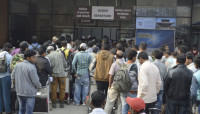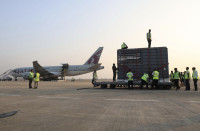Opinion
Shift in strategy
HIV infections should be treated immediately instead of waiting for signs of illness
Binod Rayamajhee
The human immunodeficiency virus (HIV), derived from primate lentiviruses, is the etiologic factor for acquired immune deficiency syndrome, better known by its acronym AIDS. The illness was first described in 1981, and HIV-1 was isolated by the end of 1983. Nepal saw its first case of HIV/AIDS in 1988. Since then, AIDS has become a worldwide epidemic, expanding in scope and magnitude with HIV infections affecting different populations and geographic regions. Millions are now infected worldwide; once infected, individuals remain infected for life. Within a decade, if left untreated, the vast majority of HIV-infected individuals develop fatal opportunistic infections as a result of HIV-induced deficiencies in the immune system.
Expansion of antiretroviral therapy (ART), combination of several antiretroviral medicines, has resulted in a stark reduction of AIDS-related deaths. ART was started in Nepal in February 2004 from Shukraraj Tropical and Infectious Diseases Hospital, Teku. Currently, ATR services are being provided from 61 sites in 55 districts, and regular counting of CD4 cells is being done at 28 centres.
The history
It’s been 34 years since the first case of HIV was detected. Today, increasingly effective preventive efforts have reduced the number of new HIV infections. Since the epidemic’s peak in 2004, the number of deaths has fallen by 42 percent with some 7.8 million lives being saved over the last 15 years, according to a new World Health Organisation (WTO) report. The number of new infections has fallen by 35 percent since the turn of the century. Over the last 15 years, a scale-up of ART has been most dramatic in the WHO African Region where now more than 11 million people are receiving HIV treatment, up from 11,000 at the turn of the century. People living with HIV in Africa are now more likely to receive treatment than people living in most other parts of the world. Globally, in June 2015, close to 16 million people out of a total 37 million people living with HIV were receiving ART.
A safe and effective vaccine offers the best hope of controlling the AIDS epidemic. Viral vaccines are typically preventive, which means they are given to uninfected individuals to prevent either infection or disease. However, all the candidate HIV vaccines tested as of 2009 proved ineffective at preventing infection. The development of a vaccine is difficult because HIV mutates rapidly, is not expressed in all cells that are infected, and not completely cleared by the host immune response after primary infection. Without control by drugs or vaccines, the only way to avoid an epidemic spread of HIV is to maintain a lifestyle that minimises high risks factors. There is a risk of infecting others through sexual intercourse (vaginal or oral), oral-genital contact, or sharing needles. In Nepal, unsafe sex accounts for 85 percent of HIV transmission. Consistent and proper use of condoms can reduce transmission of the virus, though protection is not absolute.
Scenario in Nepal
There were 39,249 HIV infected patients in Nepal at the end of 2014, and among them, 25,449 were male, 13,800 female and 59 third gender. Breaking down the infected population into age groups, the highest number 28,809 are aged 15-49 years, 1,968 are aged 0-14 years and 8,412 are aged 50 years and above. This data shows that the prevalence rate of the 15-49 age group is 0.2 percent while the global average is 0.8 percent. There were 11,089 patients (5,652 males and 5,604 females) with HIV (PLHIV) receiving ART as of July 2015.
In Nepal, there is a concentrated epidemic of HIV infection, which means that the rate of HIV infection in vulnerable groups is more than 5 percent while the rate for the general population is less than 1 percent. During the period January-July 2015, there were 46 HIV positive deliveries, and 59 among the 79,431 pregnant women tested for HIV were positive. In 2014, the number of children infected by HIV totalled 178, down 62 percent from 2010. During the year 2014, a total of 2,578 patients died due to AIDS, down 22 percent from the figure in 2007.
According to recent statistics, the rate of infection among drug users is 6.4 percent in Kathmandu, 2.8 percent in Pokhara and 8.3 percent in the Tarai. The figure for female sex workers is 2 percent in Kathmandu while the rate of infection among the gay population is 2.4 percent. Likewise, the rate of HIV infection in the Western Region is 0.3 percent and in the Mid- and Far Western regions, it is 0.6 percent each. In a bid to prevent transmission from infected pregnant mothers to the child, 98 HIV test centres have been set up for pregnant women. Regular coordination between the local community and public stakeholders is vital for the continuation of the Test, Treat and Retain programme.
One of the most successful prevention methods in the market today, PrEP is vital to defeating HIV. It stands for Pre-Exposure Prophylaxis and is a pill taken once a day, which when taken correctly, virtually eliminates chances of getting HIV. AIDS researchers have released a call to action for a worldwide shift in HIV treatment from first watching for signs of illness to appear to providing medication immediately after diagnosis. Figures prove that immediate antiretroviral (ARV) treatment more than doubles an individual’s prospects of staying healthy and surviving. HIV infections have dropped 35 percent from 2000, but the world needs to dramatically step up investment as well as access to treatment.
Rayamajhee holds an MSc in Medical Microbiology from Tribhuvan University




 18.12°C Kathmandu
18.12°C Kathmandu









%20(1).jpg&w=300&height=200)

